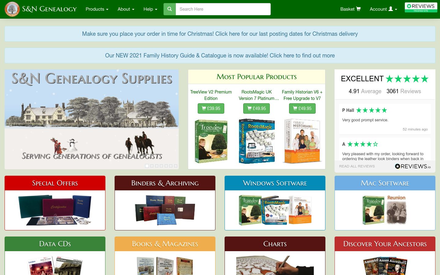




Finding an Ancestor in a Death Record - Florence Nightingale
Florence Nightingale died in London on the 13th August, 1910, at the age of 90. To find her death record, I first had to log into TheGenealogist and select BMD Indexes to search. Then, after typing in the forname and surname, I chose the year 1910 to search in, and clicked search. There were four pages found for the results - these were for each quarter of the year (Jan-Mar, Apr-Jun, Jul-Sep, and Oct-Dec). Knowing she died in August, I chose to view the Jul-Sep results, and found her near the bottom of the first page. You can see the results in the image on the right. Florence Nightingale - A Short Biography
Nightingale was courted by politician and poet Richard Monckton Milnes, but she rejected him, convinced that marriage would interfere with her ability to follow her calling to nursing. When in Rome in 1847, recovering from a mental breakdown precipitated by a continuing crisis of her relationship with Milnes, she met Sidney Herbert, a brilliant politician who had been Secretary at War. Herbert was already married, but he and Nightingale were immediately attracted to each other and they became lifelong close friends. Herbert was instrumental in facilitating her pioneering work in Crimea and in the field of nursing, and she became a key advisor to him in his political career. In 1851 she rejected Milnes' marriage proposal against her mother's wishes.
The Crimean War & the Return HomeFlorence Nightingale's most famous contribution came during the Crimean War, which became her central focus when reports began to filter back to Britain about the horrific conditions for the wounded. On October 21, 1854, she and a staff of 38 women volunteer nurses, were sent (under the authorization of Sidney Herbert) to Turkey, where the main British camp was based. Nightingale arrived early in November 1854 in Scutari. She and her nurses found wounded soldiers being badly cared for by overworked medical staff in the face of official indifference. Medicines were in short supply, hygiene was being neglected, and mass infections were common, many of them fatal. Nightingale and her compatriots began by thoroughly cleaning the hospital and equipment and reorganizing patient care. However, during her time at Scutari, the death rate did not drop; on the contrary, it began to rise. During her first winter at Scutari, 4077 soldiers died there. Ten times more soldiers died from illnesses such as typhus, typhoid, cholera and dysentery than from battle wounds. Conditions at the hospital were fatal to the patients because of overcrowding, defective sewers and lack of ventilation. A sanitary commission was sent out in March 1855, which flushed out the sewers and improved ventilation. Death rates were sharply reduced.
In response to an invitation from Queen Victoria – and despite the limitations of confinement to her room – Nightingale played the central role in the establishment of the Royal Commission on the Health of the Army, of which Sidney Herbert became chairman. As a woman, Nightingale could not be appointed to the Royal Commission, but she wrote the Commission's 1,000-plus page report that included detailed statistical reports, and she was instrumental in the implementation of its recommendations. The report of the Royal Commission led to a major overhaul of army military care, and to the establishment of an Army Medical School and of a comprehensive system of army medical records. Later Career
In 1869 Nightingale and Elizabeth Blackwell opened the Women's Medical College. By 1882 Nightingale nurses had a growing and influential presence in the embryonic nursing profession. In 1883 Nightingale was awarded the Royal Red Cross by Queen Victoria. By 1896, Florence Nightingale was bedridden. (She may have had what is now known as chronic fatigue syndrome.) During her bedridden years, she also made pioneering work in the field of hospital planning, and her work propagated quickly across England and the world. In 1907 she became the first woman to be awarded the Order of Merit. She died on August 13, 1910. The offer of burial in Westminster Abbey was declined by her relatives, and she is buried in the graveyard at St. Margaret Church in East Wellow, Hampshire. |
FREE SEARCH - Burial Records - Death Records - Find Records - Case Study - Links
S&N Genealogy - Links
Vast online research site - the widest coverage of records from 1127 to 2005, and all the data is checked by experts for accuracy and quality. 
A site full of advice on how to research your family tree for free, including free genealogy websites and free family history subscriptions. 
The index to the complete range of birth, marriage and death records (BMD) from 1837 onwards - that's 168 years of data, or 250 million events! 
Easy-to-use online research site, ideal for the beginner. Pay-as-you-Go service from just £5, only pay to view a full record, searching is FREE! 
Information about the UK Census.
1921 Census - 1911 Census -
1901 Census - 1891 Census
ParishRecord.com - ParishRecord.net - ParishRecord.org - ParishRecord.org.uk - Flip-Pal.uk.com |




















